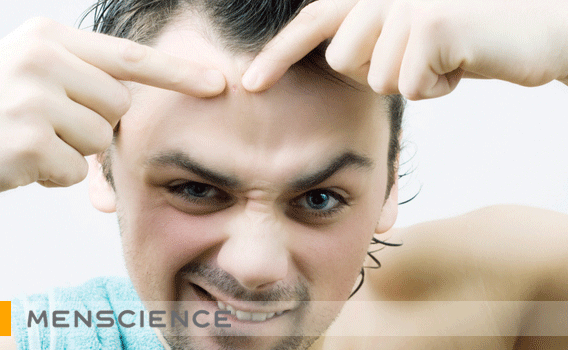Pimples. Zits. Spots. No matter how you say it, acne is something men have to deal with their entire lives, not just during the teenage years. But to properly treat acne, it’s necessary to understand how acne is caused and what it really is.
The most common type of acne is acne vulgaris. This can be triggered by several factors, including hormone imbalance, overproduction of sebum (the oily substance on the skin) and growth of bacteria (known as P. acnes).
Acne forms when pores become clogged with sebum, dead skin cells and bacteria. If the clog occurs below the skin surface, this creates a “whitehead.” If the clog reaches the surface, a “blackhead” forms (the black is not actually dirt; its bacteria which darkens when exposed to oxygen). Clogged pores can pop and spread oil, causing more pimples and lesions. For this reason, exfoliation with gentle, effective products (not abrasive) is an integral part of an acne treatment regimen for men as it regularly removes the blockage of dead cells from pores.
Because men’s glands are larger and produce more sebum (or oil), acne is typically more prevalent among men than women, especially when it comes to back acne. In fact, it’s the male hormone (androgen) that is responsible for activating the glands that produce oil and sebum in the first place…
Editor’s Note – Want the latest men’s skincare news and exclusive MenScience offers? Sign up for our newsletters!
While external factors do not play a direct role in causing acne, they can aggravate an acne condition. These factors include improper cleaning, using inferior products, food allergies, an improper or vitamin deficient diet, an imbalance in skin’s PH structure (since skin acidity is what controls acne bacteria), climate (heat and humidity both contribute to more acne bacteria production), and stress.
You can take several steps to improve acne treatment and control acne:
* It’s important to keep skin clean without over-cleansing, as this can cause a greater production of oil to compensate the moisture lost by washing. Use a liquid cleanser with salicylic acid like Daily Face Wash.
* Reduce the bacteria that cause breakouts by using an acne treatment product such as Acne Spot Repair.
* Make sure that you use an ultralight sunscreen like TiO2 Sunblock SPF 30, as sun exposure increases oil production.
* Most importantly, keep skin clean and hydrated with an oil-free moisturizer (we recommend Advanced Face Lotion).









